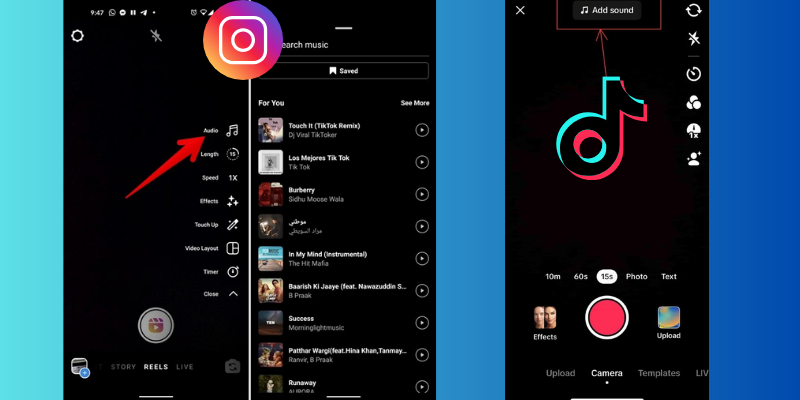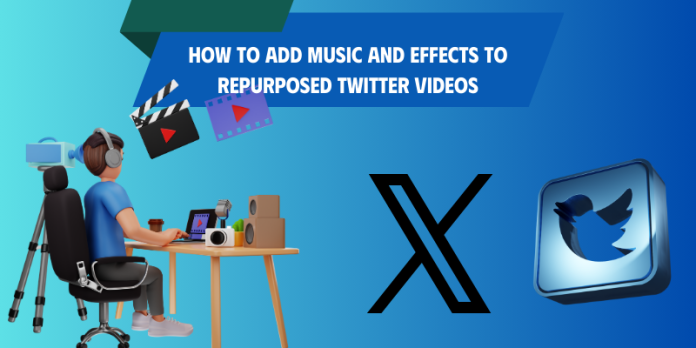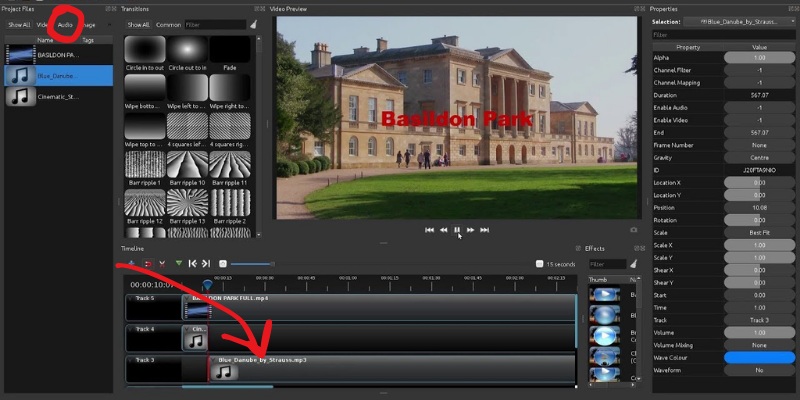Transforming Twitter videos into fresh content is a popular strategy for content creators. When you repurpose videos from Twitter to other platforms, you’ll often need to enhance them with music or effects to match each platform’s style and avoid copyright issues. This guide will show you how to add the perfect soundtrack and visual effects to your repurposed Twitter videos, helping you create engaging content that resonates with your audience while staying within platform guidelines.
Why add sound and effects to your Twitter video?
Sound can make basic Twitter videos more compelling that captures attention and drives engagement across platforms. By adding carefully selected music tracks and sound effects, you can create distinct emotional atmospheres that align with your brand voice while avoiding copyright issues. The right audio elements help your repurposed content stand out in crowded social feeds.

How Music and Effects Enhance Engagement
Music taps directly into viewers’ emotions, helping you craft specific moods that reinforce your message. Upbeat tracks can energize product demonstrations, while softer melodies work well for storytelling moments. Your sound choices act as emotional signposts, guiding viewers through the narrative of your video while boosting retention rates by up to 65%.
Sound effects add another dimension to your repurposed content by emphasizing key moments and transitions. Simple effects like whooshes, pops, or subtle background ambiance create professional polish that keeps viewers watching. These audio cues also help break up longer clips into more digestible segments for platforms like TikTok and Instagram Reels.
The Role of Sound in Viral Content
Trending sounds and popular music snippets can significantly boost your video’s shareability. Platform-specific audio trends, like TikTok’s viral sounds or Instagram’s music library, give your repurposed Twitter content cultural relevance and increased discovery potential. Videos with trending audio elements see up to 2.5x more shares than those without sound.
The strategic use of sound hooks viewers within the first few seconds – a critical factor for viral potential. By front-loading engaging audio elements, you create an immediate connection that encourages viewers to watch through to the end. Matching your sound design to platform-specific trends while maintaining brand consistency helps your repurposed content perform better across different social networks.
Analytics show that videos using a combination of music and sound effects generate 47% more engagement than those with just one audio element. Testing different audio combinations helps you identify what resonates best with your audience while building a signature sound style that viewers come to recognize and expect from your content.
Simple Tools for Elevating Your Video Experience
Top User-Friendly Video Editing Software to Consider
Desktop editing software like OpenShot and VSDC Free Video Editor offer straightforward interfaces for adding music and effects to your repurposed Twitter videos.
OpenShot particularly stands out with its drag-and-drop functionality and built-in audio library, making it perfect for beginners looking to enhance their content.
VSDC Free Video Editor provides more advanced features like audio mixing and voice-over capabilities while maintaining an approachable learning curve.
For Mac users, iMovie remains a reliable choice with its extensive sound effects library and ability to extract audio from other videos. The software seamlessly integrates with your existing music library and offers precise audio timing controls that help you sync sound effects with specific video moments.
Mobile Apps That Make Adding Sound Effortless
InShot and Splice lead the pack for mobile video editing, offering robust audio features that work perfectly for Twitter video repurposing.
InShot includes a vast library of royalty-free music and allows you to trim, fade, and adjust volume levels with simple touch controls.
Splice distinguishes itself with a clean interface and the ability to layer multiple audio tracks, giving you more creative control over your final mix.
VivaVideo and Quik provide additional mobile editing options with their specialized features for social media content. VivaVideo excels at automatic beat-matching, while Quik can analyze your video and suggest music that matches its pace and mood. Both apps include copyright-safe music libraries that update regularly with fresh content.
These mobile solutions also support direct importing from your music library and cloud storage services. You can quickly add trending songs, voice-overs, or sound effects while maintaining the original video quality. Most importantly, these apps export in formats optimized for various social platforms, ensuring your enhanced videos maintain their audio-visual quality across Twitter, TikTok, and other networks.
Explore more tools to edit Twitter videos
How to Add Music and Effects into Your Video
| Software Needed | Video editor (DaVinci Resolve, Adobe Premiere, or Filmora) |
| File Types Supported | MP4, MOV, AVI (downloaded Twitter videos) |
| Audio Formats | MP3, WAV, AAC |
Importing Your Twitter Video into Editing Software
Start by downloading your chosen Twitter video using SnapTwitter, which provides high-quality MP4 files ready for editing. Open your preferred video editing software and create a new project matching your target platform’s specifications – for instance, 9:16 aspect ratio for TikTok or 1:1 for Instagram.
Drag your downloaded video into the editor’s media pool, then place it onto the timeline. Most editing software automatically creates a sequence matching your video’s properties, saving you time on manual adjustments. Your video will serve as the foundation for adding music and effects in the following steps.
Choosing and Adding the Perfect Soundtrack
Select music that complements your video’s mood and pacing. Popular royalty-free music platforms like Epidemic Sound or YouTube Audio Library offer extensive collections sorted by genre, mood, and tempo. For TikTok repurposing, consider trending songs or sound effects that can boost engagement and discoverability.
Add your chosen audio track to a separate timeline layer, positioning it to align with key moments in your video. Adjust the audio levels to maintain a balance between the original video sound (if keeping it) and your new soundtrack – typically, background music should sit around -15 to -20 dB.
Fine-tune your music integration by trimming the track length, adding fade-ins/fade-outs at appropriate points, and using audio keyframes to create dynamic volume changes. This helps emphasize specific moments and maintains professional-quality sound throughout your repurposed content.
Add Music and Effects into Your Video on IG/Tiktok
If you want to repurpose a Twitter video for Instagram or TikTok, you don’t need to stress about editing software — both platforms let you add music and effects right inside the app.

Here’s how it works: after trimming or cropping your Twitter video with a tool of your choice, simply upload it to Instagram or TikTok. On the editing screen, you’ll see an option like “Add sound”, “Music”, or a little 🎵 icon. Tap it, search for the song or sound effect you want, and apply it to your video.
You can also explore filters, text, and visual effects to make your clip more engaging. This is one of the easiest ways to adapt your Twitter content so it feels natural on platforms where music and trends drive attention.
Polishing Your Video for Maximum Impact
Adjusting Audio Levels and Effects for Clarity
Balance your audio tracks by setting the background music between -15 to -20 decibels while keeping dialogue or main audio at -6 to -12 decibels. This mix ensures your added music enhances rather than overpowers the original content. Use your editing software’s audio mixer to fine-tune the fade-ins and fade-outs, creating smooth transitions between different audio elements.
Apply audio effects selectively to enhance your video’s mood and engagement. Bass boost can add depth to music tracks, while noise reduction helps clean up any background interference. For platform-specific optimization, consider adding a subtle reverb effect to make music feel more spacious on mobile devices, where viewers often use earbuds or phone speakers.
Optimizing for Different Platforms
Each social platform has specific requirements for optimal video performance. For TikTok and Instagram Reels, export in 1080×1920 resolution at 30fps, while Twitter performs best with 1280×720 at 30fps. Set your video bitrate between 3-6 Mbps for HD content, ensuring smooth playback without excessive file sizes that could slow down uploads.
Choose the right format for your target platform – MP4 with H.264 encoding works universally well across social media. For TikTok-bound content, keep your file size under 287.6 MB, while Twitter videos should stay within 512 MB for optimal loading speed and viewer experience.
Consider creating multiple versions of your video with different aspect ratios: 9:16 for Stories and Reels, 1:1 for feed posts, and 16:9 for YouTube or Twitter. This approach ensures your content looks professional and properly formatted regardless of where your audience discovers it. Use platform-specific features like captions, hashtags, and calls-to-action that align with each platform’s best practices.
To wrap up
Taking this into account, your journey to transform Twitter videos with music and effects opens up endless creative possibilities. You can effectively dodge copyright issues while making your content more engaging by adding your own audio elements and visual effects. When you repurpose videos for platforms like TikTok, Instagram, or YouTube Shorts, these modifications help your content blend seamlessly with each platform’s unique style and audience expectations.
As you move forward with your video repurposing strategy, you’ll find that these customizations not only protect your content legally but also help boost your engagement rates. Whether you’re adding trending music to catch TikTok viewers’ attention or incorporating subtle effects to enhance your message, these tweaks can transform an ordinary Twitter video into platform-specific content that resonates with your target audience. Your ability to adapt and enhance content this way is a valuable skill in today’s fast-paced social media landscape.


